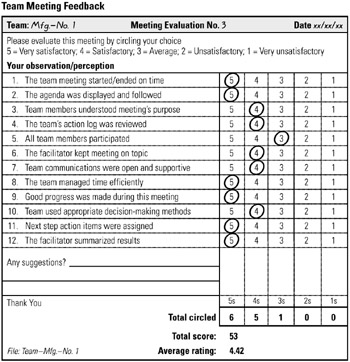Tool 197: Team Meeting Evaluation
| AKA | Meeting Process Check |
| Classification | Team Building (TB) |
Tool description
The team meeting evaluation surveys provide timely feedback on the effectiveness of the problem-solving process, team dynamics, and the administrative procedures used to ensure that the team stays focused and is moving toward its goals.
Typical application
-
To evaluate a team's process and progress.
-
To periodically monitor the effectiveness of team meetings.
-
To search for areas of improvements.
Problem-solving phase
| Select and define problem or opportunity | |
| → | Identify and analyze causes or potential change |
| Develop and plan possible solutions or change | |
| Implement and evaluate solution or change | |
| → | Measure and report solution or change results |
| → | Recognize and reward team efforts |
Typically used by
| Research/statistics | |
| Creativity/innovation | |
| Engineering | |
| 3 | Project management |
| Manufacturing | |
| Marketing/sales | |
| Administration/documentation | |
| Servicing/support | |
| 2 | Customer/quality metrics |
| 1 | Change management |
before
-
Circle response
-
Buzz Group
-
Surveying
-
Relationship Map
-
Interview Technique
after
-
Rotating Roles
-
Team Process Assessment
-
Sociogram
-
Different Point of View
-
Critical Dialogue
Notes and key points
-
Participants' completed meeting evaluation forms should be summarized after each meeting and process/progress results fed back to the team. Use the team process assessment tool for this purpose.
-
The use of Likert scale designations (very satisfactory to very unsatisfactory, strongly agree to strongly disagree, etc.) is best determined by the team.
Step-by-step procedure
-
STEP 1 After every team meeting, or periodically if the team decides it, participants fill out the team evaluation survey form.
-
STEP 2 The team leader or team facilitator summarizes all responses and compares the results with those of the previous meeting. Of particular interest may be the rating averages and any patterns or variations from the expected results.
-
STEP 3 The rating results and suggestions made are discussed at the beginning of the next scheduled team meeting.
-
STEP 4 All completed forms should be dated and saved for pattern analysis.
Example of tool application
Team Meeting Feedback

EAN: 2147483647
Pages: 326